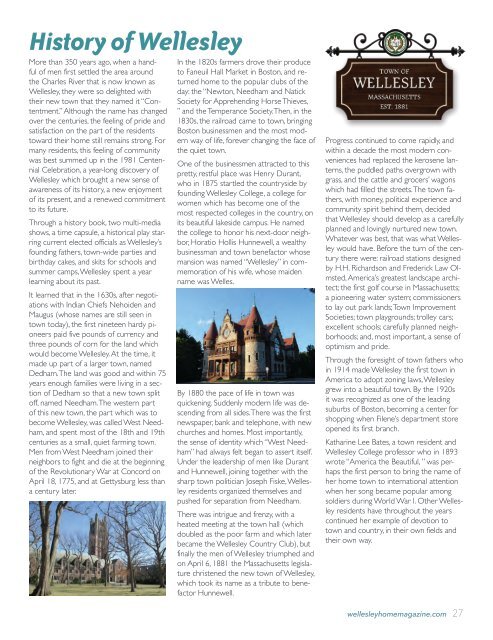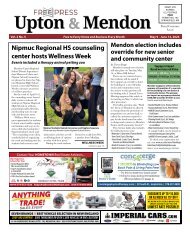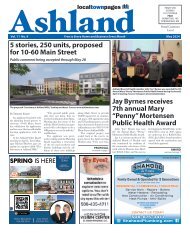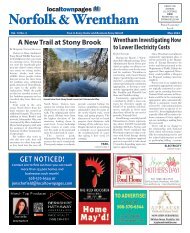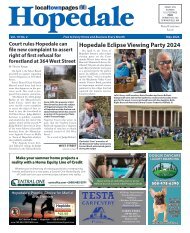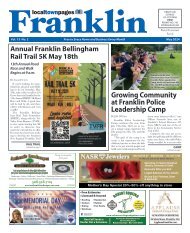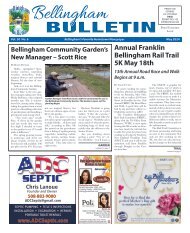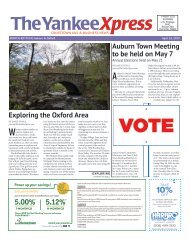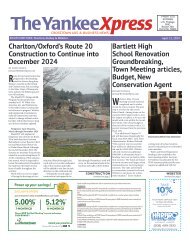Wellesley Home Magazine 2022-23
Wellesley Home Magazine 2022-23
Wellesley Home Magazine 2022-23
You also want an ePaper? Increase the reach of your titles
YUMPU automatically turns print PDFs into web optimized ePapers that Google loves.
History of <strong>Wellesley</strong><br />
More than 350 years ago, when a handful<br />
of men first settled the area around<br />
the Charles River that is now known as<br />
<strong>Wellesley</strong>, they were so delighted with<br />
their new town that they named it “Contentment.”<br />
Although the name has changed<br />
over the centuries, the feeling of pride and<br />
satisfaction on the part of the residents<br />
toward their home still remains strong. For<br />
many residents, this feeling of community<br />
was best summed up in the 1981 Centennial<br />
Celebration, a year-long discovery of<br />
<strong>Wellesley</strong> which brought a new sense of<br />
awareness of its history, a new enjoyment<br />
of its present, and a renewed commitment<br />
to its future.<br />
Through a history book, two multi-media<br />
shows, a time capsule, a historical play starring<br />
current elected officials as <strong>Wellesley</strong>’s<br />
founding fathers, town-wide parties and<br />
birthday cakes, and skits for schools and<br />
summer camps, <strong>Wellesley</strong> spent a year<br />
learning about its past.<br />
It learned that in the 1630s, after negotiations<br />
with Indian Chiefs Nehoiden and<br />
Maugus (whose names are still seen in<br />
town today), the first nineteen hardy pioneers<br />
paid five pounds of currency and<br />
three pounds of corn for the land which<br />
would become <strong>Wellesley</strong>. At the time, it<br />
made up part of a larger town, named<br />
Dedham. The land was good and within 75<br />
years enough families were living in a section<br />
of Dedham so that a new town split<br />
off, named Needham. The western part<br />
of this new town, the part which was to<br />
become <strong>Wellesley</strong>, was called West Needham,<br />
and spent most of the 18th and 19th<br />
centuries as a small, quiet farming town.<br />
Men from West Needham joined their<br />
neighbors to fight and die at the beginning<br />
of the Revolutionary War at Concord on<br />
April 18, 1775, and at Gettysburg less than<br />
a century later.<br />
In the 1820s farmers drove their produce<br />
to Faneuil Hall Market in Boston, and returned<br />
home to the popular clubs of the<br />
day: the “Newton, Needham and Natick<br />
Society for Apprehending Horse Thieves,<br />
” and the Temperance Society. Then, in the<br />
1830s, the railroad came to town, bringing<br />
Boston businessmen and the most modern<br />
way of life, forever changing the face of<br />
the quiet town.<br />
One of the businessmen attracted to this<br />
pretty, restful place was Henry Durant,<br />
who in 1875 startled the countryside by<br />
founding <strong>Wellesley</strong> College, a college for<br />
women which has become one of the<br />
most respected colleges in the country, on<br />
its beautiful lakeside campus. He named<br />
the college to honor his next-door neighbor,<br />
Horatio Hollis Hunnewell, a wealthy<br />
businessman and town benefactor whose<br />
mansion was named “<strong>Wellesley</strong>” in commemoration<br />
of his wife, whose maiden<br />
name was Welles.<br />
By 1880 the pace of life in town was<br />
quickening. Suddenly modern life was descending<br />
from all sides. There was the first<br />
newspaper, bank and telephone, with new<br />
churches and homes. Most importantly,<br />
the sense of identity which “West Needham”<br />
had always felt began to assert itself.<br />
Under the leadership of men like Durant<br />
and Hunnewell, joining together with the<br />
sharp town politician Joseph Fiske, <strong>Wellesley</strong><br />
residents organized themselves and<br />
pushed for separation from Needham.<br />
There was intrigue and frenzy, with a<br />
heated meeting at the town hall (which<br />
doubled as the poor farm and which later<br />
became the <strong>Wellesley</strong> Country Club), but<br />
finally the men of <strong>Wellesley</strong> triumphed and<br />
on April 6, 1881 the Massachusetts legislature<br />
christened the new town of <strong>Wellesley</strong>,<br />
which took its name as a tribute to benefactor<br />
Hunnewell.<br />
Progress continued to come rapidly, and<br />
within a decade the most modern conveniences<br />
had replaced the kerosene lanterns,<br />
the puddled paths overgrown with<br />
grass, and the cattle and grocers’ wagons<br />
which had filled the streets. The town fathers,<br />
with money, political experience and<br />
community spirit behind them, decided<br />
that <strong>Wellesley</strong> should develop as a carefully<br />
planned and lovingly nurtured new town.<br />
Whatever was best, that was what <strong>Wellesley</strong><br />
would have. Before the turn of the century<br />
there were: railroad stations designed<br />
by H.H. Richardson and Frederick Law Olmsted,<br />
America’s greatest landscape architect;<br />
the first golf course in Massachusetts;<br />
a pioneering water system; commissioners<br />
to lay out park lands; Town Improvement<br />
Societies; town playgrounds; trolley cars;<br />
excellent schools; carefully planned neighborhoods;<br />
and, most important, a sense of<br />
optimism and pride.<br />
Through the foresight of town fathers who<br />
in 1914 made <strong>Wellesley</strong> the first town in<br />
America to adopt zoning laws, <strong>Wellesley</strong><br />
grew into a beautiful town. By the 1920s<br />
it was recognized as one of the leading<br />
suburbs of Boston, becoming a center for<br />
shopping when Filene’s department store<br />
opened its first branch.<br />
Katharine Lee Bates, a town resident and<br />
<strong>Wellesley</strong> College professor who in 1893<br />
wrote “America the Beautiful, ” was perhaps<br />
the first person to bring the name of<br />
her home town to international attention<br />
when her song became popular among<br />
soldiers during World War I. Other <strong>Wellesley</strong><br />
residents have throughout the years<br />
continued her example of devotion to<br />
town and country, in their own fields and<br />
their own way.<br />
wellesleyhomemagazine.com 27


